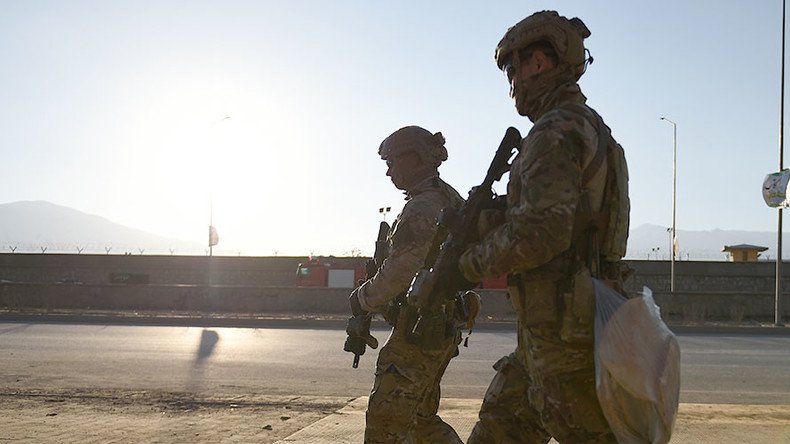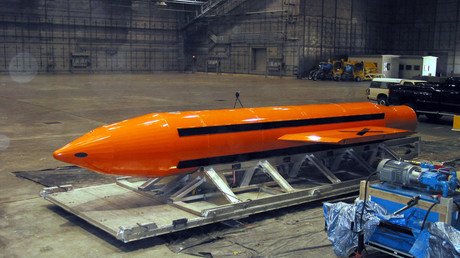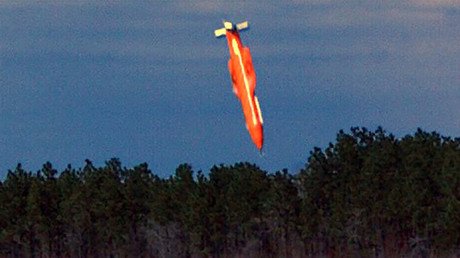Pentagon claims US troops battling Islamic State near site of Afghan MOAB airstrike

US troops continue to battle Islamic State fighters near the site where an 11-ton “mother of all bombs” was dropped last week in Nangarhar province, on the Afghanistan border. An estimate of the number of militants killed has risen to 94.
After arriving at the site the day after last Thursday’s airstrike, US troops fighting alongside Afghan forces have since left, but continue to conduct operations in the broader area, said US military spokesman Captain William Salvin.
“Access has been restricted but that's because it's a combat zone,” Salvin told Reuters. “We are in contact with the enemy.”
Echoing initial estimates, Salvin said the US military has “high confidence” that no civilians were harmed in the Massive Ordnance Air Blast attack. The MOAB, the US’s largest non-nuclear bomb, has also been referred to as the “mother of all bombs.” The US said it still has the blast site on lockdown, and not even Afghan security forces or press have been allowed in the site area.
US troops have continued to use explosives to collapse other tunnel entrances not destroyed by the bomb, Salvin said.
The number of Islamic State (IS, formerly ISIS/ISIL) fighters killed in the attack has risen to 94, an Afghan official said over the weekend, a number confirmed by the US military officials on Wednesday. A figure of 36 was reported a day earlier.
“Fortunately, there is no report of civilians being killed in the attack,” Ataullah Khogyani, a spokesman for the provincial governor in Nangarhar, told the Associated Press. He said a clearance operations to assess the site of the attack was continuing.
‘Only #ISIS base used to launch attacks was destroyed, no civilians harmed’ – Afghan MoD on US #MOAB strike https://t.co/ltRyZ4plcZ
— RT (@RT_com) April 14, 2017
An Afghan Defense Ministry official had said Friday that the number of dead could rise as officials assessed the bomb site in Achin district.
Several villages near the blast site have been largely abandoned for months as fighting increased between IS and the US-backed Afghan forces, locals said, according to Reuters.
“There were daily bombings and fighting,” Khan Afzal, a local policeman on a recent patrol in the village of Abdul Khil, less than a mile from the strike, told Reuters.
“Afghan forces used to fire artillery, bombs were dropped by foreign aircraft, and even Daesh fired rockets at us and at the villagers,” he added, using an Arabic term for Islamic State.
Questions have surrounded the decision to use the bomb, the largest of conventional bombs ever used in combat by the US military, which drew condemnation from some prominent figures, including former Afghan president Hamid Karzai and Afghanistan's ambassador to Pakistan.
Karzai in an interview aired on Monday denounced the use of the bomb as a “brutal act” and an “insult” to Afghanistan. He stressed an immediate end to brutalities against his country.
“The US [must] engage with the Afghan people towards a peaceful solution where we can live in our own country peacefully,” the ex-president told Al-Jazeera after the massive bombing.
“A bomb of that magnitude has consequences for the environment, for lives, for our plants, for our water, for our soil - this is poison, a poison that will be there for years,” he added.
Aerial photos from the bomb site show a massive dark area.
Some Afghan officials have complained about the lack of information about the effects of the bomb.
“We were and we are kept in the dark and still we haven’t been able to go to the site,” said one senior Afghan security official, who declined to be named because of the sensitivity of the issue.
“We are confused ourselves and we wonder what MOAB could have caused.”
Afghanistan President Ashraf Ghani’s office said last Friday there was “close coordination” between the US military and the Afghan government on the operation, and they were careful to prevent any civilian casualties.
The US estimates 600 to 800 IS fighters are in Afghanistan, mostly in the province. The US has concentrated on fighting them while also supporting Afghan National Security Forces against the Taliban. The US has more than 8,000 soldiers in Afghanistan, training local forces and conducting counterterrorism operations.














